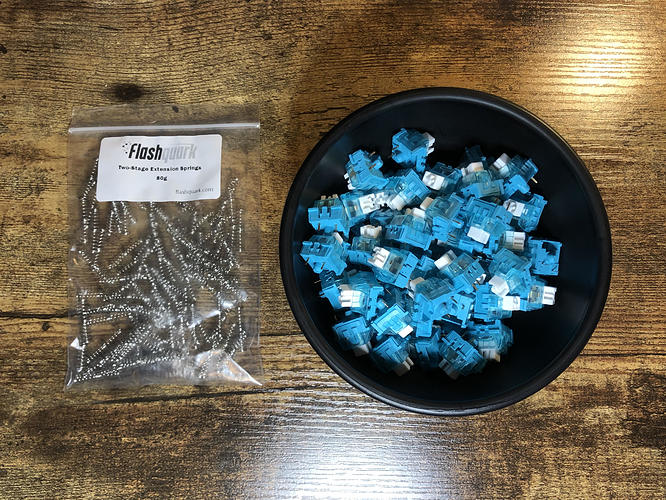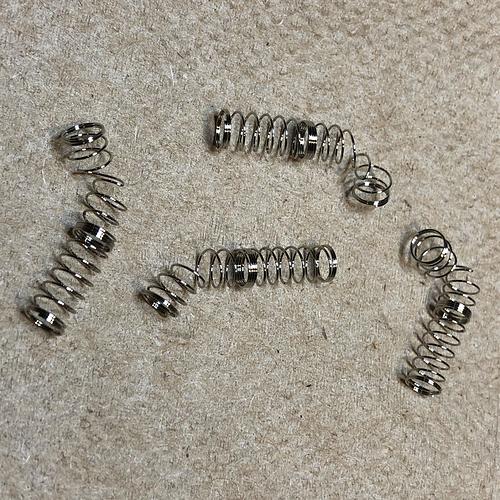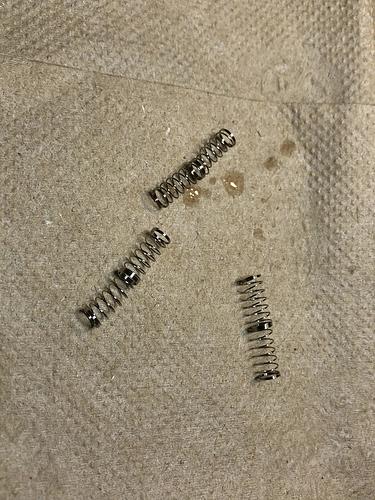These Icebergs are too light for me, so they’ll be my testing platform for these 80g long springs.
I got the 62g Flashquark two stage springs from 3Dkeebs & tried them out in lubed Gat Ink reds. They definitely felt much heavier than a 62g bottom out, I’d say at least a good 10g heavier if not more. What is the weighting rated on? I could see myself liking these longer springs, but I’d need much lower weightings. Like 40g or 35g on whatever weighting rating is being used. Beyond the weighting I did like the ultra firm upstroke these sprigs produce & think I’d be able to bottom out much less using a 2 or 3 stage spring that I liked the weighting of. I can definitely see why these are so popular for uber tactile switches too!
Those are bottom-out weight. If flashquark’s force curve graph is accurate, those 62g springs start out at 50g at the top of the keypress, which may explain why they felt 10g heavier.
Honestly, it would do the community a lot of good if all the vendors could put out force graphs for the springs they sell.
That is a possibility, just the way higher amount of pre load on the spring. I agree a force curve would be nice & help a ton with buying springs!
Agreed! That said, I’d love to see some kind of standardization between manufacturers in terms of how the measuring is done. The internals of different switches will pre-load and compress springs to different degrees; some housings have a little shelf the spring sits on, while some have a little trough it settles into, etc.
Maybe some device that measures the spring by itself, showing the force vs how close each end of the spring is to the other, if that makes sense.
That’s not my experience with them. The 58g I have feels nice and soft with a firm rebounce.
Another thing I was wondering with mine is if I didn’t get heavier springs accidently mislabeled as the 62g ones. Everyone I’ve talked to that has used them had pretty much the same take you have.
@Deadeye That’s a good point. The internal of a switch does affect the force curve. A simple way to standardize this is to draw the force curve using something like a cherry black. Although I imagine that is what they have been using. Otherwise, they wouldn’t be able to give us the bottom-out weights. Based on Hooke’s law, putting a 62g tx spring in a short travel switch (e.g. yellow ink) would result in a lighter than 62g bottom-out feel due to the lack of full travel.
A simpler alternative to force curve graphs would be giving us both the initial and the bottom-out forces. Initial force is a more precise metric than the length of spring , which is what is currently widely used (14mm, 15mm, 16mm, 22mm…)
I’ve been wishing more manufacturers would do this for years. High-five for those that do.
That curve could make them a great choice for Ergo Clears.
MX Clears want to actuate at about ~50 G, and bottom out at least ~62 G, if possible.
So that’s a ‘minimum spring for effective Ergo Clear operation,’ potentially.
I got 14.5mm 62g spring in my clears, they seem to work fine, but I almost never use them because the batch of clear I got are quite scratchy 
I’ve been using the 80g “dual-stage” long springs for a couple days now and early impressions are positive.
Like pretty much any long spring I’ve used so far, there’s going to be some amount of chatter and/or ring unless you lube them - so I gave all but a few control samples a nice trip through a tub of 106.
I’m finding these springs a lot more usable as dailies than I expected; they strike a surprisingly good balance for me of resisting accidental depression and not wearing out my fingers. It could be because I’ve done lots of typing in the mean time, but I find these a lot more usable than the Cherry Silent Blacks I used to have at work.
I’ll be giving some more complete thoughts after I’ve had a week or two with these, but I figured I’d share my positive feelings so far.
I’d say the only negative for me right now has nothing to do with the springs themselves; maybe five or six were crushed in shipping, and maybe two or three more were wonky in a more subtle way with just the middle tight coil being off-kilter enough to crunch and/or settle during travel.
they ded
Some crunchy ones - vast majority made the trip just fine, though. I think even a modest little cardboard box or something would protect the springs.
Sorry about the crushed springs, that is definitely my fault. I figured for sample purposes, they could just ship in a regular letter envelope, but overlooked the fact that they might get crushed in transit.
We normally ship these springs in our standard packaging with a good amount of bubble wrap so they are well protected.
I’m glad to hear that you like the springs though!
Do you mind letting me know what switches you were using the springs with?
I figured that might be the case and that the envelope was just for the samples - the Nashville distribution center can be a little rough on mail. ; )
Sure! Right now I’m testing them in Aflion Iceberg switches; you can actually see a photo from the swapping process here:
The Iceberg switches already had some two-stage springs in them, but I rarely used the switches because they were too light for me. The 80g springs make them much more enjoyable for me.
I also tried the springs in a different switch last night, probably something they’re much less likely to be used for normally: TTC Gold Brown V3 housings with Gazzew Phoenix clicky stems. The Phoenix stems are similar to typical click-jacket / “blue switch” stems but the shape of the clicky bit is different. I noticed that some part of that stem, likely this unusual jacket, experiences some interference with two-stage springs - the switch makes it past the tactile event, but hits a point just past that where it stops before bottom-out. Pushing just a little harder will produce a slight “crunch” sound and feeling that gives way to a normal bottom-out.
My guess is that the center tight coil is getting caught on the unconventional jacket shape - this is a very niche condition but I thought it could be possibly useful for you to know about the interaction. I’ve tried two other kinds of more traditional click-jacket stems that have zero interference issues with the two-stage springs.
I’ve had a little more time with the 80g dual-stage springs, and at least for my own tastes, I think I’ve honed-in on the use-case I’ll be keeping them around for.
After a few solid work-days with these, I do find my fingers a bit tired or strained. Typing on them is very satisfying, though, and they resist accidental activation effectively. That being the case, I’ll be using these for gaming, browsing, editing, and other situations with light amounts of typing.
I’ll also note these affect the sound of the switches I’m using them in. At least with my fingers, the bottom-out gets a little softer with more energy absorbed by the spring, and the top-out gets clackier with that same energy delivered to the top housing via the stem.
I do agree that they’re are clackier.


